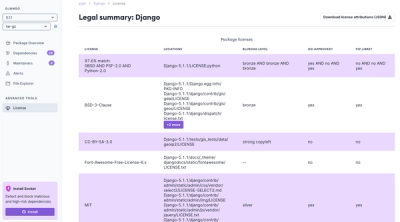
Product
Introducing License Enforcement in Socket
Ensure open-source compliance with Socket’s License Enforcement Beta. Set up your License Policy and secure your software!
github.com/lugu/qiloop

QiMessaging is a network protocol used to build rich distributed applications. It is created by SoftBank Robotics and is the foundation of the NAOqi SDK and the Pepper SDK.
libqi is the implementation of QiMessaging used in Pepper and NAO. It is open-source and developped here: https://github.com/aldebaran/libqi.
For an in-depth overview of the protocol, visit this description of QiMessaging.
QiLoop is another implementation of QiMessaging. It has two main goals:
Disclaimer: QiLoop is not affiliated with SoftBank Robotics.
Read the FAQ.
Client and server sides are functional.
Service directory and log manager are implemented as part of the
standalone server (launched with qiloop server).
Features:
type supported: object, struct, values, map, list, tuple
actions: method, signals and properties are fully supported
cancel: client support only (see motion example)
transport: TCP, TLS, UNIX socket
authentication: read the credentials from $HOME/.qiloop-auth.conf
service introspection: generate IDL from a running instance (use qiloop scan)
IDL files: generate specialized proxy and service stub (use qiloop stub)
stats and trace support
QiMessaging exposes a software bus to interract with services. Services have methods (to be called), signals (to be watched) and properties (signals with state). A naming service (the service directory) is used to discover and register services.
To connect to a service, a Session object is required: it represents the connection to the service directory. Several transport protocols are supported (TCP, TLS and UNIX socket).
With a session, one can request a proxy object representing a remote service. The proxy object contains the helper methods needed to make the remote calls and to handle the incomming signal notifications.
Services have methods, signals and properties which are described in an IDL
(Interface Description Language) format. This IDL file is process by the
qiloop command to generate the Go code which allow remote access to the
service (i.e. the proxy object).
Installation:
go get -u github.com/lugu/qiloop/...
Documentation: http://godoc.org/github.com/lugu/qiloop
How to create a proxy to an existing service: follow the ALVideoDevice tutorial.
How to create your own service: follow the clock tutorial.
Basic examples:
hello world illustrates how to call a method of a service: this example calls the method 'say' of a text to speech service.
signal registration illustrates how to subscribe to a signal: this example prints a log each time a service is added to the service directory.
Examples for NAO and Pepper:
animated say uses ALAnimatedSpeech to animate the robot.
posture puts the robot in a random position.
motion move the robot forward and demonstrate how to cancel a call.
memory uses ALMemory to react on a touch event.
Examples of service implementation:
ping pong service illustrates how to implement a service.
space service illustrates the client side objects creation.
clock service completed version of the clock tutorial.
$ qiloop -h /home/ludo/qiloop
qiloop - an utility to explore QiMessaging
___T_
| 6=6 |
|__`__|
.-._/___\_.-.
; \___/ ;
]| |[
[_| |_]
Usage:
qiloop [info|log|scan|proxy|stub|server|trace]
Subcommands:
info - Connect a server and display services info
log - Connect a server and prints logs
scan - Connect a server and introspect a service to generate an IDL file
proxy - Parse an IDL file and generate the specialized proxy code
stub - Parse an IDL file and generate the specialized server code
server - Starts a service directory and a log manager
trace - Connect a server and traces services
Flags:
--version Displays the program version string.
-h --help Displays help with available flag, subcommand, and positional value parameters.
If you need to provide a login and a password to authenticate yourself
to a server, create a file $HOME/.qiloop-auth.conf with you login on the
first line and your password on the second.
FAQs
Unknown package
Did you know?

Socket for GitHub automatically highlights issues in each pull request and monitors the health of all your open source dependencies. Discover the contents of your packages and block harmful activity before you install or update your dependencies.

Product
Ensure open-source compliance with Socket’s License Enforcement Beta. Set up your License Policy and secure your software!

Product
We're launching a new set of license analysis and compliance features for analyzing, managing, and complying with licenses across a range of supported languages and ecosystems.

Product
We're excited to introduce Socket Optimize, a powerful CLI command to secure open source dependencies with tested, optimized package overrides.